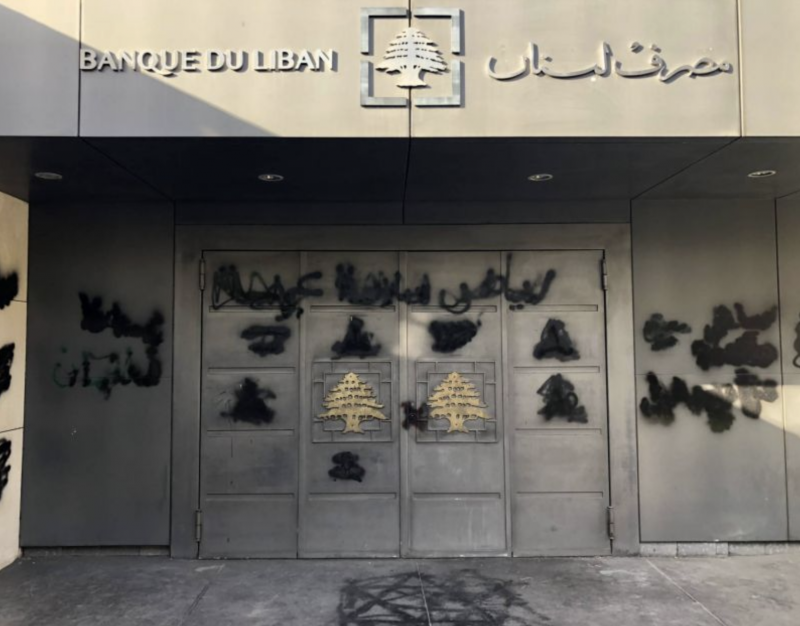
Barred doors at Banque du Liban, Lebanon's central bank, as graffiti is blacked out from protests since the banking crisis began in 2019. (Credit: Philippe Hage Boutros/L'Orient-Le Jour)
Lira losses accelerated over election weekend, dropping 11 percent since Thursday to trade today at LL30,000 to the US dollar.
There is an old saying on Wall Street that markets hate uncertainty. The recent parliamentary elections have likely added a new twist to an already complex financial and economic situation. Jostling between the newly-elected MPs could threaten the naming of a new Prime Minister and the formation of a new government. The International Monetary Fund can wait before approving the final deal, but Lebanon's finances cannot.
Below are some of the factors to watch for in the coming weeks.
Here’s what we know:
• The central bank’s balance sheet dated May 15, shows foreign assets have dropped to $16.06 billion from $17.82 billion at the beginning of the year, yet when adjusting the number for the Eurobonds, the Special Drawing Rights and the pending payments to the private sectors, the number drops to $9 billion or $10 billion.
• The balance sheet further shows that the $1.8 billion spent by the central bank since the start of the year on the stabilization of the lira, had minimal effect on money in circulation. The amount of lira in circulation outside of Banque du Liban dropped by just 10 percent to LL27 trillion from LL30 trillion while the lira is back to the same levels it was trading at in December and January.
• Simple math also shows that the drop of LL3 trillion in money in circulation when compared to the depletion of $1.8 billion in reserves, is rather modest. As if the central bank sold the dollars and purchased the lira at a rate of LL1,650.
• There is speculation whether the central bank will renew Circular 158 next month. The circular allows the withdrawals of up to $800. Some $400 in USD banknotes, another $200, but in lira banknotes converted at the rate of LL12,000 to the US dollar, and finally, another $200 converted to lira but with the funds deposited in an account and accessed with a payment card. The circular was released on June 8, 2021, with a deadline of June 31, 2022.
• The circular’s advantage is that half of the $800 is taken out in US dollars and that reduces the final haircut born by the depositors when the lira depreciates.
• Another circular close to the deadline is Circular 151. The circular allows depositors to withdraw US dollars at a rate of LL8,000 to the dollar. It was initially released on April 21, 2020 and is valid until June 30, 2022.
• The deadline for Circular 161 is the end of May. The circular was repeatedly extended by the central bank since mid-December. It elaborates the mechanism by which the central bank can intervene in the currency market by selling unlimited amounts of US dollars.
• The failure to renew any of the above circulars, will carry negative consequences on the stability of the financial system and will create panic among depositors. An event that could send the lira in a cycle.
• The Sayrafa platform has also demonstrated how the central bank’s grip on the currency market is slipping. The gap between the parallel market rate and the Sayrafa rate is back above LL5,000. This divergence was observed in December when the lira embarked on a parabolic rise reaching LL33,400 to the US dollar and at the time, forcing the central bank to devise a more aggressive intervention strategy.
• The government’s plan to write off $60 billion in deposits is already facing stiff resistance from the depositors, the private sector, the banking sector and soon from the newly-elected parliament. The government either must change course and draft a new plan to speed up the reforms process or the country will witness further social unrest.
• International commodity prices remain elevated on the back of the Russian war on Ukraine. The ton of wheat is at the highest price since at least 10 years trading at $435. The price of Brent oil is currently at $114 per barrel. The Baltic Dry Index (BDI), which measures changes in the cost of transporting various raw materials by sea, such as coal and steel, is 40 percent higher from the level at the start of the year. And despite the recent loan of $150 million from the World Bank, supply issues continue to threaten food security as India has recently banned wheat exports further pressuring prices.